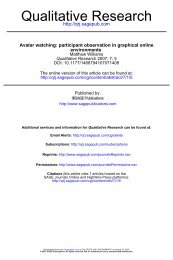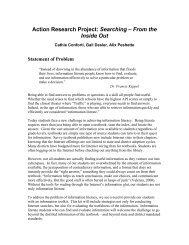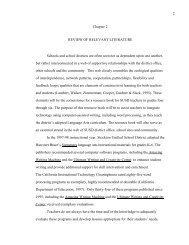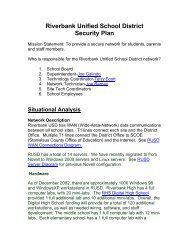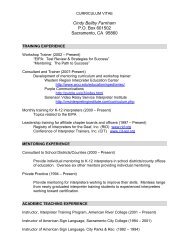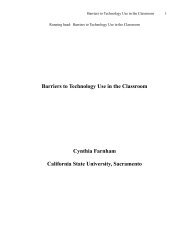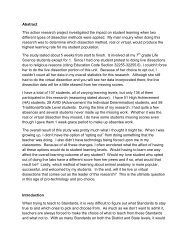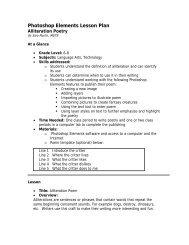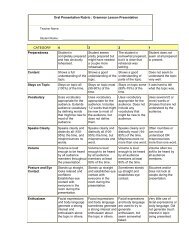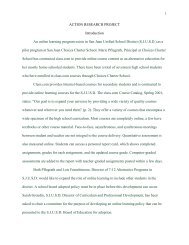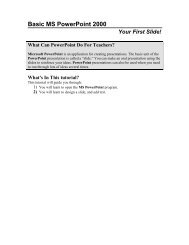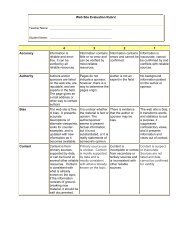Literature Review (pdf) - iMET
Literature Review (pdf) - iMET
Literature Review (pdf) - iMET
You also want an ePaper? Increase the reach of your titles
YUMPU automatically turns print PDFs into web optimized ePapers that Google loves.
group oriented and whose axis are specific problems that the groups may choose themselves orhave assigned to them. Like in Dewey’s model the teacher acts as a facilitator to the grouprather than a presentation source of information. The context for the project subject matter islarger than the immediate lesson, offering self-discovered generalities. Students will conductresearch using multiple sources of information, usually touching on a number of disciplines. Theproject timeline usually extends over a significant period of time, from several class periods tolonger spans. Secondary component goals of project-based learning include students increasingtheir time budgeting skills, increasing their problem-solving abilities, and collaboration skillsimprovement. The culminating product is often a presentation, sometimes using multimedia thatcan be used or viewed by others. Assessment often includes individual self-assessment, groupassessment, and instructor assessment.When teachers ask students to meet these challenges, when teachers ask them to producean end product, teachers push students into the demands of the real world. A review of relevantliterature reveals how the world is filled with these challenges that students will face one day;and it is the teacher’s job to give them a head start to face this unknown life ahead of them(Gardner, 2000). Project-based learning is a medium that allows our students a guided headstart. This guidance is key. Without a well-prepared teacher, students flounder in the unknownand cannot find their way out.Project-based Learning and TechnologyProject-based learning "focuses on central concepts and principles of a discipline,involves students in problem-solving investigations, allows students to work autonomously toconstruct own knowledge, and culminates into realistic products" (Buck Institute of Education,2002, p. 1). Hence, project-based learning, based on this definition, presents students with5
problems that require them to seek answers by conducting research, making connections betweendata, challenging themselves to seek resources, and assimilating ideas into existing schemata.The innovative power of project-based learning is evident when compared to the traditionallecture model of teaching. For instance, learning is perceived as a personal, reflective, andtransformative process where ideas, experiences, and points of view are integrated (Sandholtz,Ringstaff, & Dwyer 1997). The purpose of project-based learning using technology is to shiftthe focus of learning away from the teacher and places it on the student.For instance, project-based learning that utilizes technology helps students to internalizeand personalize ideas; to create situations where skills and concepts can be applied in differentcontexts to explore ideas, and synthesize knowledge (Sandholtz, et al.1997). It also helpsdevelop and enhance higher-order thinking skills, such as analysis, synthesis, and evaluation,unlike the traditional model of teaching, which imprisons students at the knowledge andcomprehension level of Bloom's Taxonomy. In addition, project-based learning usingtechnology propels students toward higher order thinking because it requires them not only toaddress a problem or task, but also to effectively plan, research, create, and present projectsusing a technology tool.A review of relevant literature reveals that project-based learning that integratesinformational technology benefits students in numerous ways: they learn self-reliance, how todesign, carry out, and evaluate a project, and more importantly, they learn in an authentic andchallenging environment (Moursund, 1999). Learning with computers engages students becauseof their inquisitive nature. Some mind tools that would aid students in project-based learningare: spreadsheets, databases, search engines, and multimedia publishing tools.6
to ensure they are on task and sharing responsibilities (Green & Brown). When technology isinvolved competence should be achieved in presentation software skills (usually PowerPoint),graphical organizer software skills (usually Inspiration), Web research techniques, and wordprocessing.Learning Theories and Educational Philosophies:Overview of Learning Theory“If a man does not keep pace with his companions, perhaps it is because he hears a differentdrummer. Let him step to the music which he hears, however measured or far away.” -HenryDavid ThoreauThe above quote is good advice for the education world. It is a wake up call, a reminderthat students are unique individuals. The Merriam Webster Dictionary defines intelligence as,“The capacity to acquire and apply knowledge.” Taking this definition into account the questionthen becomes this, are students, as Piaget believed, a blank slate with capacity to be filled by anymeans or do students have specific capacities to learn already? Is intelligence something youacquire over time, or is something with which you are born? For the purpose of this study theresearchers believe that intelligence is innate, that the job of educators is to discover howstudents are already intelligent and teach them to use their innate gifts to navigate the real-world.According to Joseph Walters of Harvard University,[The traditional] view of intelligence as a singular trait presents us with difficulty.When we try to apply it to human behavior in the world, we find that many peoplewho display particular talents and proclivities do not “test well” on our measuresof intelligence. For example, in the Harvard Square street scene, we may find thatthe backgammon player can answer certain questions on the IQ test quiteaccurately but has trouble with others; the musician displays a very differentpattern of answers. In other words, we can identify talented individuals in theworld, but we do not find that the trait of intelligence, as revealed by intelligencestests, has much to do with these talents. Indeed, when we look at the variety of8
things that people can do, we begin to think that there might be more to‘intelligence.’ (Walters, 1992, para. 8).If this is taken into consideration, intelligence is not something that can be measured accuratelyon any given standardized test. Asking students to recite information rather than show how andwhat they learned, is not optimal.In fact, research reveals that people have a multitude of instincts (Jung, 1976). Theseinstincts or “archetypes” drive a person from within (Jung, 1976). No instinct is more importantthan another’s but it is the body’s preference to think rather than feel or be extroverted more thanintroverted that determine each person’s psychological type (Jung, 1976). Jung proposed thatpeople are not the same; their patterns in attitude are as inborn as their eye color. People,therefore, are intelligent and creative in their own way. They desire to learn different things inschool and will in turn succeed in different kinds of work. To ignore these differences and treateveryone the same is to stifle the individual potential of each person (Keirsey, 1998).Taking this into consideration, Howard Gardner’s theory of multiple intelligences is not anew theory but instead a theory which stems from the thinkers who came before him. It is hisbelief that people are intrinsically smart and it is the job of the educator to discover the kinds ofintelligence a student already possesses and cater learning to them whenever possible. Inaddition, students should be exposed to all intelligences so that they can achieve roundedexcellence (Gardner, 1999). The following table by Antonio Cantu (2000) summarizesGardner’s eight intelligences:9
Form of IntelligenceLogical/MathematicalVerbal/LinguisticVisual/SpatialMusical/RhythmicBody/KinestheticNaturalistInterpersonalIntrapersonalCentral ComponentsDiscern logical or numerical patterns; deductive reasoningUse written and oral language to express complex meaningPerceive the visual world accurately; create mental imagesProduce and appreciate forms of musical expressivenessControl body movements and handle items skillfullyRecognize patterns and distinctions in the natural worldUnderstand others; discern verbal and nonverbal cuesUnderstand oneself; engage in self-reflection andmetacognitionVisit http://mcel.pacificu.edu/ for a detailed graphic on Gardner’s eight intelligences.A review of relevant literature identifies how Gardner’s Multiple Intelligences theory provides a“model for educators to provide students with a deeper understanding” (Cantu, 2000, para. 4).His theory also changes how teachers look at students and their potential to learn and to create.Since students learn in different modalities, it is crucial to teach to those modalities. Gardner’stheory is suited to reach all students, especially those with learning disabilities, physicalimpairments, or other limitations.Hence, the learning environment must be a mini-model of the skills needed to besuccessful outside the classroom. Gardner explains that learners are best served with intrinsicmotivations through student’s pursuit of learning because it is enjoyable or rewarding. Teachersneed to create activities and lessons that allow students to engage and commit to teachingthemselves. The goal of teachers is to put students in the “flow state” as much as possible. This10
means creating a space, in which an individual becomes so absorbed, so focused on an activitythat they temporarily lose track of time, space, problems, and even pain (Gardner, 2000).Teachers desire that students actively engage in learning. Integrating technology in classroomsencourages this type of engagement, in which students lose track of time because they areengrossed with their projects. In order to encourage this level of engagement, teachers mustchange the manner in which they teach. Teachers must create an atmosphere of studentcentered,interest driven curriculum, where students can show the teacher, and themselves, theirability. Gardner’s Multiple Intelligences theory supports this type of student-centeredenvironment through his emphasis on adapting instruction to meet varied needs of students.Technology in Education & Learning Theories/IntelligenceWhile research shows that integrating technology improves learning, there are severallearning theories that bolster the positive effects of technology in the classroom. Learning is nota simple process, but a complex one that requires analyses on various levels in order tounderstand it. Several relevant learning construction theorists include, Jean Piaget, HowardGardner, Lev Vygotsky, and John Dewey. All of which have implications for technology in theclassroom. Constructivism, Multiple Intelligences, and Zone of Proximal Development are allsignificant with regard to project-based learning using technology. Learning theory applied totechnology is in the midst of a revolution in which researchers and theorists are arguing aboutwhat exactly it means to know and how we come to know (Jonassen & Land, 2000). Thisemerging theory is called constructivism.Constructivism proposes that students construct meaning based on experiences. Howlearners construct knowledge depends upon prior knowledge of the subject, how they organizedthose experiences into existing schemata and the beliefs they used to interpret events11
encountered (Jonassen, 2000). A review of relevant literature reveals that teachers who relyheavily on textbooks provide students with only one view of complex truths (Brooks, 1999).These same teachers stress the importance of a student's ability to "demonstrate mastery ofconventionally accepted misunderstandings instead of the construction of new knowledge”(Brooks, 1999, p. 102). Teaching with technology provides students with a broad range ofunderstanding. They are not targeted with a barrage of questions, and then tested on them.However, teaching with technology allows them to view complex truths from a variety of angles.Piaget's theory asserts, "construction is superior to instruction" (Mooney, 2000, p. 61). Toclarify, children learn by doing; they create meaning based on what is going on, rather thanreceiving explanations from adults (Mooney, 2000). For example, if a teacher showed studentsvia projector how to conduct research on the Internet, this activity would expand their knowledgebase. In contrast, if a teacher shares information on how to conduct research on the Web, andthen takes students to the computer lab to conduct research themselves, the process of seeking,refining, and locating information will help students construct a knowledge of how to search theWeb that they cannot achieve by watching the teacher show them how to do it. Research revealsmajor differences between traditional classrooms and constructivist classrooms (Brooks, 1999).For instance, in the traditional model students are viewed as a tabula rasa or blank slate ontowhich the teacher etches information, curriculum focuses on basic skills, teachers seek correctresponses to validate student learning, assessment of learning viewed as separate from teachingand occurs almost entirely through testing (Brooks, 1999). However, in constructivistclassrooms students are viewed as thinkers, curriculum is presented whole to part with emphasison big concepts, teachers seek student's point of view in order to understand their present12
conceptions for use in subsequent lessons, and students work in groups (Brooks, 1999).Constructivist theory focuses on open-ended activities that encourage higher-level thinking.Research reveals that technology-based activities and projects are types of open-endedactivities that students need to enhance and support their cognitive development because they askstudents to think (Mooney, 2000). Armed with Piagetian theory, educators are likely to presentsuch content and ideas in ways that are developmentally appropriate (Gardner, 2000). Such anapproach to learning places the learner center-stage. Constructivist approaches to learning striveto create environments in which learners actively construct their own knowledge, rather thanrecapitulating the teacher's interpretation of the world (Jonassen, 2000). Piaget's theorymaintains that once students can relate to a concept, they see meaning in it and develop a senseof ownership. This sense of ownership exudes when students are allowed to create a project thatutilizes technology, especially for students who had been withdrawn. In the constructivistmodel, students take on their responsibilities in the learning process. To sum, a constructivistframework challenges teachers to create environments that encourage students to think andexplore for themselves, rather than passively learn. This is a formidable challenge. To dootherwise is to perpetuate the ever-present behavioral approach to teaching and learning (Brooks,1999).Recent research by Howard Gardner bolsters the construction theory introduced byPiaget; however, Gardner's Multiple Intelligence’s theory takes knowledge construction evenfurther. Like constructivism, Gardner's theory changes how teachers view students and theirpotential to learn. His theory addresses the multiple ways of learning and understanding thatstudents bring with them to the classroom (Cantu, 2000). Gardner's theory hinges on a truismthat learners do not learn in the same way. In the Multiple Intelligence theory, there are several13
powerful entry points to diverse concepts: narrative, numerical, logical, existential, aesthetic,kinesthetic, and interpersonal (Gardner, 1999). These seven ways of knowing hold thatintelligence is not static. "Intelligence can be learned, taught, and developed" (Kim & Kellough,1998, p. 76). Research reveals that when students understand this, "they tend to be moremotivated to work at learning than when they believe intelligence is a fixed entity" (Resnick &Klopfer, 1989, p.8). In addition, students have differing learning styles. Some are aural learners,some visual, some kinesthetic. Teachers need to modify how they teach in order to address thesedivergent styles of learning. Teaching with technology touches on each of the "intelligences" orways of learning. When teachers properly design and implement computing andcommunications in the classroom, learning improves (Dede, 1998). Gardner's entry points ofmultiple intelligences encourage collaboration.To illustrate, the interpersonal points of entry embody the need students have to learn inthe company of other students. Projects support such interpersonal entries. By participating inengaging group projects, students have an opportunity to learn from classmates, capture theirown reactions to a topic, and make their own idiosyncratic contributions to a group effort(Gardner, 1999). The Multiple Intelligence theory's proposal that students learn and understanddifferently explains why students who learn via traditional instructional model do not appreciate,nor understand material or concepts as deeply as students who are permitted to learn and exploreutilizing technology. Hence, effective integration of technology is conducive to learning basedon Gardner’s theory.Another theorist who conducted extensive research on cognition and mental processeswas Lev Vygotsky. His work focused on the development of the individual's reorganization oflower psychological functions to form new higher ones while emphasizing that psychological14
functions are themselves historical-cultural constructions (Daniels, 2000). One of the mostprominent concepts of Vygotsky's theory is the zone of proximal development, known as theZPD. The zone of proximal development is defined as the level at which a child is able toperform independently and his or her ability to perform collaboratively. He believed that a childon the edge of learning a new concept could benefit from working with another student orteacher. The assistance provided by a classmate or teacher is referred to as scaffolding (Mooney,2000). Vygotsky's findings reinforce project-based learning using technology because the powerof such projects lies in collaboration and scaffolding. A teacher who is skilled in developingproject-based lessons using technology can help students design projects that are consistent withtheir learning abilities and interests (Moursund, 1999). Much of Vygotsky's research focused onhow school instruction provided the social and cultural context for developing higher mentalfunctions (Dixon-Krauss, 1996).Hence, project-based learning using technology is rooted in Vygotskian theory. A reviewof relevant literature reveals, "technology tools provided models, opportunities for higher levelthinking, and metacognitive guidance in a learner's zone of proximal development" (Jonassen &Land 2000, p. 15). In addition, technology-based projects enable students to represent theirthinking in concrete ways and to visualize and test the consequences of their reasoning (Jonassen& Land 2000). Vygotsky's theory encourages students to think about learning, think aboutthinking, and think about their roles in the learning process. When teachers can get their studentsto this level of understanding, they elevate their student's zone of proximal development.The scaffolding referred to earlier is an aspect of Vygotsky's work that adds credence toproject-based learning using technology. To illustrate, technology based projects such asstudents researching the Web can help bridge the gap between a child's actual development and15
potential development. With regard to assessment, the zone of proximal development "implies aneed to design ways to evaluate student's performance while engaged in actual instructionalactivities" (Dixon-Krauss, 1996, p.15). Cole and Griffin offer several aspects of Vygotsky's zoneof proximal development that clarify the role of the teacher during an instructional activity. Theteacher relinquishes role as center of attention, like in constructivist model, and allows student"to develop novel, creative understandings and analyses during social interaction" (Dixon-Krauss, 1996, p. 15). Piaget, Gardner, and Vygotsky's research significantly influence howteachers teach; moreover, they provide crucial insight into how students learn.The last contributor to learning theories is John Dewey. John Dewey's contributions toeducation were deeply rooted in democratic ideals. He believed that students were innatelycurious, and if given meaningful tasks, they become active problem solvers seeking to carry outheir own purposes (Tozer, et all, 1995). Like Piaget, Gardner, and Vygotsky, Dewey believedthat students desired active engagement; they are naturally inquisitive. Children learn best whenthey interact with others (Mooney, 2000). In Democracy and Education Dewey maintained thatstudents learn by doing. In addition, he dispelled the notion that students learn via absorption ofknowledge. They should not be spectators, but participators in the acquisition of knowledge. Intraditional classrooms, thinking is artificial because students learn what they are taught to learn(Dewey, 1916). Effective thinking involves meaningful experiences.Project-based learning utilizing technology encourages such thinking. It is rooted inDewey's philosophy, which proposes that when students are presented with a problem, andwrestle with the problem, then they are thinking and they are learning (Dewey, 1916). Deweyproposed this almost a century ago, yet his philosophy is extremely relevant today. In a shared16
activity like a WebQuest, the teacher is a learner, and the learner is a teacher. In order to providestudents with these and other educational experiences, teachers must:1. Have a strong knowledge base and knowledge about their students,2. Be willing to guide students to a greater, deeper understanding based on their knowledgeand experiences,3. Invest in observation, planning, organization, and documentation (Mooney, 2000).A teacher's knowledge base, especially in the age of technology, must include understanding therole and impact of technology in the classroom. However, in order to teach a new concept ortool, teachers must activate and build upon student's prior knowledge.The four learning theorists outlined above have significantly impacted how teachersteach, and revealed how students learn. A common thread – ownership, holds all together.When students are allowed to seek meaning on their own, the material becomes relevant. Piagetstressed that only when students are allowed to construct meaning, they learn. The fourresearchers outlined are by no means the only authorities on thinking and learning; however,their theories reinforce the power of collaboration, project-based learning, and more importantlytechnology in the classroom.In many cases, educators must justify the use of computers, technology and its integrationinto education. A review of relevant literature proposes, “that research should look at technologynot as a medium to deliver information but in the context of the learner actively collaboratingwith the medium to construct knowledge” (Roblyer, 2003, p.13). There are several valid reasonsfor technology-integration in education. Some of the reasons are motivation, gaining learnerattention, linking learners to learning tools and information sources, cooperative learning, andalso for problem-solving and higher-order thinking skills. Students are better able to visualize17
problems and solutions through the use of technology and software. Teachers are also able totrack learner progress more efficiently.There are many ways to motivate students to learn, and technology addresses differentneeds for different students, such as the cognitive, motivational and social needs of at-riskstudents. Technology gains the students’ attention while also engaging the learner throughproductive work. Research shows “gaining the learner’s attention is a critical first event inproviding optimal conditions for instruction”(Gagne, 1965, p. 60). Technology-infused lessonsencourage students to focus on the task by addressing divergent learning modalities (Pask-McCartney, 1989). Technology also links learners directly to the information sources such as theInternet, while also helping the learners to visualize problems and solutions. Moreover, studentsare motivated by creating their own technology-based products, and feel they are in control oftheir own learning (Arnone & Grabowski, 1992). This is referred to as intrinsic motivation. Inother words, students are motivated by the awareness that they are learning. “Learner controlseems to have special implications for at-risk students and others who have experiencedacademic failure” (Roblyer, 1991, p.13). Technology also links learners to learning tools and toeducational sources. “Some unique affective benefits have also been observed; includingincreased multicultural awareness, as students of different cultures interact online” (Roblyer,1991, p. 12). “The engaging qualities of technology resources such as multimedia and theInternet allow teachers to set complex, long-term goals that call for basic skills, thus motivatingstudents to” (Roblyer, 2003, p.13). Therefore, technology-based projects promote cooperativelearning, shared intelligences and increase problem solving and higher-order cognitive skills.18
Change in the K-12 Classroom via Technology IntegrationTeaching is a profession that sees change on a regular basis. It has undergone a"paradigm shift" and is headed towards "standards alignment". The culture of school curriculumis one of constant flux. Teachers, who are unwilling to alter their way of teaching to includetechnology to help students meet these standards, are doing their students a great disservice. Amajor reason for teachers' avoidance of such change is that they are not appropriately trained todeal with it. Today, teachers are faced with the arduous task of integrating technology when theywere not taught how to, or they simply refuse to learn something new. They fail to realize thatsomething as simple as teaching students rudimentary keyboarding skills could help them get ajob in the future. Preservice teachers are not prepared to teach, or taught how to teach (Fullan,2001). Research reveals the importance of redesigning teacher education programs to focus ondeveloping the beginners' knowledge base for making changes in the conditions that affectteaching (Fullan, 1993). Also programs are not preparing their students for the real world(Fullan, 1993). A change in teaching needs to occur at the preservice level. The 'knowledgebase' previously mentioned must include utilizing technology in the classroom. Teachers whoare apprehensive are either afraid of failing or are complacent or comfortable with their years ofmemorized, monotonous lessons. They fail to realize that they are depriving their students of ameaningful education.In Apple Classrooms of Tomorrow, researchers conducted a study that created differentforms of learning and teaching using technology, instead of having technology determine what orhow the information would be taught. In addition, the study revealed how students were moreapt to learn when allowed to collaborate as opposed to working alone (Sandholtz, et al. 1997). Inaddition, teachers involved in the study had difficulty relinquishing their roles as authoritarian19
and center of attention. Project-based learning using technology encourages students to becomepart of a team; they learn responsibility. It also places student at the center of learning. Studentsbecome less and less dependent upon their teachers and construct meaning on their own throughresearch and project development.Teachers who are apprehensive about teaching with technology provide numerousreasons for their uneasiness. Among these reasons are: lack of time, knowledge, training,computers, and support. For a majority of teachers in the Apple Classrooms of Tomorrow study,time was the major issue (Sandholtz et al., 1997). It is evident that teachers have a time-intensejob, and spending hours to create, implement, and reflect upon technology-based projects andlessons is an arduous task. In addition, teachers in the study who had basic or no knowledgewith computers became frustrated and abandoned it when they could not locate help on campus.Again, having time to create, implement, and trouble shoot was a barrier to change for severalteachers in the study. A final barrier to change that Sandholtz discovered was limited access totechnology. Research reveals that, "although all participants had access to technology, whenthey returned to their schools, many teachers complained that insufficient amounts of hardwareand software impeded their progress" (Sandholtz, et al., 1997, p. 154). While all of the above areevident barriers to change, they are all areas within the teachers' locus of control. Regardingtraining, there are numerous staff members on site who are proficient in the area of instructionaltechnology.Even with computers in the classroom, teachers complained that they did not haveenough (Sandholtz, et al., 1997). There are numerous scholarly articles and books that make acase for the one-computer classroom. A review of relevant literature reveals that enquiryorientedactivities, such as WebQuests, are one way to approach limited computer access (Grey,20
2001). With regards to the lack of time, time will always be an issue, especially with the recenttrend in education to teach to the standards. Simply wiring schools with computers and theInternet is not the answer to bridging the digital divide. However, a change in how teachersregard and utilize technology is necessary. There are several myths about integrating technologythat need to be dispelled. For instance, some regard the computer as a complex tool. Thecomputer is like any other tool. The value of it lies in how well it is used (Kleiman, 2000). Thecase for computers in the classroom is bolstered by the fact that computers in the classroom:enable teachers to vary instruction, prepare students for the workforce, encourage problem andproject-based learning and collaboration, and motivates students (Kleiman, 2000). Teachers whocare about their students must address and overcome their fears regarding technology. Teachersand schools that do not utilize technology or project-based learning are shortchanging studentsand widening, rather than bridging, the digital divide.Teachers must take on leadership roles in order to effect change. In order for teachers tolead in a culture of change, they must create a culture of change (Fullan, 2001). It does not meanadopting innovations one after another; it does mean producing the capacity to seek, criticallyassess, and selectively incorporate new ideas and practices-all the time (Fullan, 2001). Teachersare leaders. Leaders are not afraid to try something new, of setting precedents. Change canevoke ambivalent feelings from consternation, frustration, and exasperation to excitement,empowerment, and improvement. Teachers must be risk takers; they must not be afraid oflearning in front of or alongside their students. They must be willing to show their students thatthey too are learning and are not infallible, but when they make mistakes they reflect upon themand learn from them.21
Collaboration is also a catalyst for change. A review of relevant literature revealed thatchange in education occurs through collaboration. When teachers collaborate, the potential forchange is greater. Such collaboration exists when there is collegiality present within a school.Four areas that define collegiality are: when staff frequently discuss instruction, when teachersobserve each other and discuss/reflect; when teachers and administrators unite to cerate lessons,plan assessment, design curriculum, and select materials; when ideas are shared that relate towhat is known about learning (Bernhardt, 1998). Change is a journey, and adventure that shouldbe faced with others who share similar experiences (Bernhardt, 1998). Although this comparisonis simplistic, it is realistic. Such change is possible when others see the value of it. Teachingstudents with technology is a worthwhile journey, not only for the teacher, but especially for thestudent.Other research bolsters the previous assertions on teachers and technology integration.For instance, the power of project-based learning on students is evidenced by its power toactively engage students. Specifically, project-based learning utilizing technology motivates,encourages collaboration, and challenges students in a way that straight lecture does not(Moursund, 1999). In addition, project-based learning using technology is designed to facilitatelearning and learning to learn. Moreover, it allows students opportunities to acknowledge andlearn from mistakes; it allows students to develop and enhance interpersonal skills, and itprovides them with opportunities to create a project of which than can be proud. Project-basedlearning using technology challenges students in a way that lecture and oral discussion do not.Teaching students how create a project using technology is not painstakingly difficult. Itsimply requires teachers to spend a few hours in a meaningful staff development session learninghow to integrate technology in the classroom. In addition, there are numerous Websites, books,22
and the like at their disposal. A simple starting point could be teaching students how to useMicrosoft Word. Implementing technology in the classroom is certainly within a teacher's locusof control. Teachers who are unwilling to utilize technology, to alter their way of teaching, neverchallenge students, nor do they provide their students with opportunities to learn from theirmistakes. Such a teacher is not concerned with his or her students, but complacent with theirpracticed, boring, and dull lessons.Motivation in the K-12 Classroom“If children can be motivated to dig deeper, they soon find on their own that history isoften useful; that math is indispensable for analyzing, measuring and quantifying; that wellhonedobservational skills and a repertoire of analytical tools are extremely helpful”Dan Page (Bishop & Hirschbuhl, 2000, p.12).Extrinsic motivation describes motivation in which actions are done for externalmotivators such as rewards or avoiding punishment. Extrinsic motivators are often overused andtheir effects rarely last (Mendler, 2000). Extrinsic motivators may reduce risk-taking, complexthinking, and also lower the quality of the students’ overall performance and behavior (Rogers,Ludington & Graham, 1998).In contrast, intrinsic motivation describes a desire that comes from within the student.Students will generally work harder and are more effective when they are intrinsically motivatedthan when motivated by extrinsic rewards (Kim 1995; Kohn 1993). Studies have shown apositive correlation between intrinsic motivation and academic achievement (Kohn 1993). Someresearch indicates that extrinsic rewards can negatively effect intrinsic motivation (Lumsden1994; Mendler 2000). “All rewards have the same effect, they dilute the pure joy that comesfrom success itself” (Kohn, 1993, p. 148). To increase intrinsic motivation, teachers can offer23
students choices, frequent feedback, contextualized activities, high expectations withoutembarrassment, and use varied and enjoyable activities that match the learning style needs andmultiple intelligences of students (Rogers, Ludington & Graham, 1998). Project-based learninghas many of these components.Others argue that intrinsic and extrinsic motivation should not be separated. Intrinsic andextrinsic motivators may simultaneously and positively affect behavior. For example, a studentmay read a book for pleasure (intrinsic motivation) and yet also gain the teacher’s approval[extrinsic motivation] (Sansone & Harackiewicz, 2000). Lepper and colleagues found thatintrinsic and extrinsic motivation was not mutually exclusive, but there was a “highly significantpositive correlation between curiosity/interest and attempting to please the teacher or receive agood grade” (Sansone & Harackiewicz, 2000, p. 275).According to the Mathematics Framework for California Public schools (1999) in aneffective mathematics programintrinsic motivation is fostered by helping students to develop a deepunderstanding of mathematics, encouraging them to expend the effort needed tolearn, and organizing instruction so that students experience satisfaction whenthey have mastered a difficult concept or skill. External reward systems are usedsparingly (p. 14).Intrinsically motivated students are more likely to earn higher grades, are more confident in theirability to learn, are more likely to persist, have longer retention and are more likely to be lifelonglearners (Northwest Regional Educational Laboratory, 2001).Factors that influence a student’s motivationA major initial factor in student motivation is their home environment. When students areraised in an environment that encourages discovery and natural curiosity, they are more likely tohave a positive view on learning (Lumsden, 1994). There is also a positive correlation between ademocratic style at home and interest in school (Stipek & Seal, 2001). Students need to feel24
competent and able, which can help them cope with the challenges of learning (Lumsden, 1994).Autonomy, responsibility, and a caring, safe environment are keys to motivating are children tolearn (Stipek & Seal, 2001).How can we increase students’ motivation to learn?No matter how excellent any instructional program is learning will be no greaterthan the student’s level of motivation. When motivation is low, learning is low.That is why many of the most sophisticated and meticulously designedinstructional systems often fail to achieve desired learning results. (Spitzer, 1996,p. 45)To maximize student motivation, students should feel capable, valued, safe and secure,happy and in “self-control” (Rogers, Ludington& Graham, 1998). Students can be highlymotivated by games and sports. Dean Spitzer analyzed the motivation factors of these activitiesand applied them to the classroom.According to Dean Spitzer (1996) the following “motivators” can create a moremotivating context for learning:Action: Active participationFun: Will students enjoy the activity?Variety: A variety of resources are used.Choice: Can learners make choices regarding the activity?Social Interaction: Will the learners be able to interact with each other?Error Tolerance: How safe is the learning environment?Measurement: Is there a positive “scorekeeping” system?Feedback: Timely and encouraging.Challenging: Activity must be appropriately challenging.25
Recognition: Positive reinforcement.Project-based learning infused with technology can satisfy these criteria. Teachers canincrease motivation by emphasizing effort, creating hope, building relationships and expressingenthusiasm, but one of the most effective ways is to give power in the form of choices (Mendler,2000). An emphasis on progress, with students self-scoring and setting goals will increasestudent motivation (Joyce & Weil, 2000). Students often select the optimum appropriatechallenge, a step beyond their current ability level (Stipek & Seal, 2001). This challenge is seenin what Lev Vygotsky defined the zone of proximal development - the “actual developmentallevel as determined by independent problem solving” and the “potential development asdetermined through problem solving under adult guidance or in collaboration with more capablepeers” (Wertsch, 1985, p. 67-68).One must provide the appropriately challenging activity with scaffolding and thenwithdraw the support, as the child is ready (Sansone & Harackiewicz, 2000). The challenge is tocreate projects with appropriate scaffolding, or structure, without confining the student.According to Jamie McKenzie (1999) appropriate scaffolding:• Provides clear directions.• Describes the activities purpose.• Keeps students on task.• Provides assessments such as rubrics and standards.• Directs the student to quality resources.• Reduces uncertainty and disappointment.• Increases efficiency.• Creates momentum.26
Engaged learners are responsible for their own learning, use problem-solving strategies,are energized by learning and work collaboratively (National Staff Development Council, 2002).Projects appropriately scaffolded can provide the opportunity for student learning.Can technology play a role in increasing student motivation?“It is nothing short of a miracle that the modern methods of instruction have not yetentirely strangled the holy curiosity of inquiry” Albert Einstein (Stipek and Seal, 2001, p 178).Research reveals that “technology improves motivation, attitude, and interest whenstudents use technology applications to produce, demonstrate, and share their work withteachers, and parents” (Center for Applied Research in Educational Technology, 2003, para. 2)Technology integration used in conjunction with innovative ideas shows increased learning andmotivation (Sandholtz, et al., 1997). A review of relevant literature reveals that "qualitativeresearch on computer-rich environments has generally supported the idea that project-basedwork with computers is highly engaging for students" (Becker, 2000, pages 5-17) WebQuests areproject-based activities that fit these criterions, and thus will hopefully increase learning andmotivation.Problem-Based Learning and the Role of TeachersA review of relevant literature reveals that John Dewey (1910) believed that schoolsshould reflect society (Wrigley, 1998). Dewey described a new model of learning in which ateacher provides a situation that is puzzling and asked students to solve the problems aftergathering data and testing the conclusions (Woolfolk, 1998). He called this model inquirylearning.In this model teachers were seen as monitors of thinking, guides of the process; theywere not to stand in front of a room and pass along information. Instead, students discovered27
information through the means in which they were able. There have been many adaptations ofDewey’s model but at the heart of every adaptation is the same idea - students are given a goal tomeet and students find the means to meet that goal.Inquiry or problem-based learning focuses on an approach in which students try toacquire knowledge with scaffolded materials (Hung, 2002). Learning is scaffolded in stepsthroughout this process, and the teacher provides the material to support the learning. Problembasedlearning leaves room for the ways in which students learn. Students actively involved inboth the process of creating meaning and the product, which proves, they have learned. Whenusing problem-based learning the following must be accounted for:1. The problem must be presented in the same way it would be presented in reality.2. Students must have room to use their own abilities and work at a level of learning thatis not above their zone of proximal development3. Material must stimulate student’s discussion, questions or issues.4. Areas to explore must be made apparent to the learner as the progress through theproblem.5. Learners must work cooperatively or collaboratively on a common task using both inand out of class time. Learners must have outside access to needed information.6. Learners must be able to label their own needs and desired resources7. The instructor works as monitor of the student's quality of learning. Instructor musthave a full understanding of all concepts.8. Instructor serves as a guide of critical thinking and provides limited resources.9. Learners must be able to applied information to problem and evaluate their ownlearning. (Hung, 2002)Students must be able to learn when they need it for the situations they encounter, ratherthan simply because the teacher believes it is desirable. The idea that students must create theirown meaning and learn out of necessity can be a threat to teachers who believe that students arepassive creatures to be filled with knowledge. The advantages to problem-based learning canthen be disadvantages to these instructors (Hung, 2002).28
When using problem-based learning it is important to remember that the model ofcurriculum uses real life problems without real structure. The problems are open-ended andoften ambiguous (Fogarty, 1997). The focus of problem-based learning is on the steps thatstudents took to solve the problem. The problem requires the student to gain knowledge,question and anticipate needs and conquer the situation they encounter. Research reveals sevenkey parts to problem-based learning.1. Defining the problem:Students take the problem at hand and put it into their own words.2. Gathering Facts:Students access prior knowledge to see what they already know that might beuseful to solving the problem. At this stage Multiple Intelligences are used torelate anything they can to the problem at hand. Students need to find out first,what they know already, what they need to know, then what they need to do.Students also begin asking questions at this phase.3. Hypothesizing:At this stage students begin creating theories or ideas as to what the answer is orhow to solve the problem.4. Researching:This is the gathering section where students begin the hard work of findinganswers to their questions and hypothesizes. At this point the teacher oftenprovides scaffolded mini-lessons to aid students on their path.5. Rephrasing the Problem:As students find answers to the problem, the problem is restated and reshape forthe result they are beginning to picture in their minds.6. Generating Alternatives:At this phase collaboration between students is key. They must discuss all thepossibilities before they can arise on a solution.7. Advocating Solutions:Finally students categorize answers as, “probable, possible or preferable”(Fogarty, 1997) before choosing the final answer they go with. When decisionmakingtime comes students must weigh all possibilities and go with the one theyhave the most faith in (Fogarty, 1997).Students and teachers must fulfill their roles to make this technique successful.Problem-Based Learning Research and Case StudiesProblem-Based Learning is an instructional method approach where students areconfronted with simulated, real-world problems, and is frequently advanced as a29
powerful and engaging learning strategy that leads to sustained and transferablelearning (Bransford, Sherwood, Hasselbring, Kinzer and Williams, 1990)Educational reformers seeking to make schools and classrooms more effectivelearning environments have frequently proposed restructuring traditionalcurriculum and instruction to engage students in meaningful problem solving(Cognition and Technology Group at Vanderbilt, 1997).In a study comparing the effectiveness of problem-based and lecture-based instruction ina high school genetics class, attitudes and student’s problem-solving skills were compared.(Visser, 2002). There were differences in motivation and also learning for the students in the twogroups. One group received the lecture/discussion treatment and the other group received theproblem-based learning treatment. The problem-based learning students reported moreconfidence in their learning; however, they also reported less motivation and less learning. In aseparate study comparing two groups of students, students enrolled in the problem-based coursewere found to be more proficient in problem solving and more successful than the comparisonstudents (Visser, 2002).Little research has been conducted within high schools comparing the effectiveness ofproblem-based learning and traditional instructional approaches. Mergendoller, Maxwell, andBellisimo (2000) compared the learning and attitudes of high school students studyingeconomics using problem-based and lecture discussion methods (Mergendoller, et al., 2000).Maxwell and Bellisimo performed additional studies comparing the effectiveness ofproblem-based instruction in 2002. A comparative study of instructional methods and studentcharacteristics employed a quasi-experimental design and random assignment of students toclasses. Four different high schools and five teachers participated in the study. The teachers hadbeen to problem-based learning economics training workshops. In addition, all of the teacherswere to use the same macroeconomics material; however, each teacher would select one class to30
teach with only the lecture and discussion style of teaching. The teachers would teach the samematerial to their other classes utilizing a problem style of teaching and were to spend equalamounts of time on the concepts in both the lecture and the problem-based learning classes.There were a total of 346 twelfth-grade students that participated in the study, and data analysiswas collected from 246 students who completed pre- and post-macroeconomics testing andtreatment. The students were pre-tested with a Likert scale on their interests in economics. Thestudents’ perceptions of problem solving, discussion and negotiation were also measured with aLikert scale. In order to test macroeconomics knowledge, a content specific test was created froma test of economic literacy. In analyzing the pretest scores of both comparison groups, asignificant statistical difference was not seen. However, there was a significant differencenoticed when analyzing post-tests between the problem-based learning class and thelecture/discussion classes. The problem-based learning classes taught by four of the fiveteachers showed more gain than the traditional lecture classes. In addition, their analysis of thedata collected showed that the problem-research approach was more effective than the lectureapproach in learning basic macroeconomics concepts (Mergendoller, et al., 2002)In another analysis for the same comparison groups, pre-test and post-test change wasmeasured by gender. The data suggested that the problem-based learning classes were morebeneficial to males, slightly. This research study showed that students’ content learning wasgreater in the problem-based class than in the traditional lecture class. The students in theproblem-based learning classes gained 4%, which equates to the difference between a grade of Band a B+ based on the maximum score of 100%. They also noted that the students’ testpreparation activities might also account for differences in standardized tests, rather than the31
teachers’ instruction method (Mergendoller, et al., 2002). In addition, the students’ interest ineconomics is a variable to be considered.While PBL was more effective than lecture/discussion teaching in increasingacademic achievement, the size of this increase, although statisticallysignificant, was not great. (Mergendoller, et al., 2002). PBL will not drasticallyincrease the achievement of all students. At the same time, our datademonstrates that it did enable the majority of students in our study to learnmore.” (Mergendoller, et al., 2002)The Role of Teachers in Project-based Learning, and Case StudiesWhen it comes to teaching, teachers engage in monotonous lecturing and testing andtotally avoiding integrating technology because of trepidation, fear of failing. These fears can beassuaged if teachers find support, someone with whom they can collaborate. Likewise, whenstudents face problems, having someone with who to share is critical. Research shows thatcollaborative discussions are primarily conversational, and of course, cooperative in nature, withindividuals contributing to the discussion (Jonassen, 2000). The role of teachers in a projectbasedlearning atmosphere is that of facilitator. Teachers are still in control of the class;however, they relinquish their cherished position as center of attention, and allow students tolearn via discovery. "What is most significant about this combination of learning processes isthe level of ownership that students feel when they are in control of the discussion" (Jonassen,2000, p.12). Students need guidance through this process. As mentioned earlier in this review,teachers enjoy being the center of attention. Many believe that teaching is telling. Students inthese traditional classrooms are not encouraged to be autonomous, critical, and analyticalthinkers. They do not learn how to problem solve, nor do they learn how to be risk takers. Forsome teachers, teaching students to search rather than follow is arduous and frightening (Brooks,1999). Even more arduous and more frightening for teachers would be the integration andimplementation of technology.32
However, research reveals numerous benefits for teachers that use project-based learningusing technology. For instance, it is designed so that the teacher will be a learner, too. Projectbasedlearning utilizing technology actively engages all students and encourages collaboration.Also, it requires students to conduct research that draws on multiple sources of information.Regarding assessment, overall assessment of students' work is authentic. Finally, project-basedlearning using technology emphasizes higher-order thinking skills (Moursund, 1999).The role of teachers is that of learner. This aspect of project-based learning is powerfulbecause it reveals that the teacher values learning. It also aids student because on why teachersshould integrate technology-based projects, the Education for All Handicapped Act, also knownas Public Law 94-142 mandates that all handicapped or disabled students receive a free andappropriate education in the least restrictive environment. In fact, all students are entitled to afree and developmentally appropriate education in the United States. Hence, having studentscreate technology-based projects such as iMovies, PowerPoint presentations, newsletters, Websites, and the like, address students' divergent learning modalities. There are several purposes forusing such projects in the classroom. A significant purpose for integrating projects in theclassroom is that by considering and accommodating individual interests, learning styles, and lifeexperiences, personal meaning to learning can be optimized (Kim & Kellough, 1998). Whenintegrating projects that utilize technology, teachers must keep in mind that they are facilitatorsand mentors. Project-based learning eliminates the 'talking-head' at the front of the classroom,and focuses on the learner. However, the teacher is still in charge and "bears the responsibilityfor curriculum, instruction, and assessment" (Moursund, 1999, p.18). Shifting from instruction toconstruction requires the teacher to relinquish role as lecturer, to become reflective, to become alearner, and to guide students in the discovery process.33
To assuage some of the fears that teachers have regarding using project-based learningutilizing technology, teachers should have professional/staff development sessions that focus onspecific areas. In addition, administrators should set aside common planning time for just that –common planning. During this time, teachers could collaborate, reflect, and discuss frustrationsand accomplishments.Case StudiesA significant amount of research has been conducted that supports project-based learning.Most of the results portrayed resulted in positive benefits in the learning environments. Projectbasedlearning seems to be very effective for procedures such as problem solving and decisionmakingskills, especially when the project chosen is one with which students can relate.Defining features of project-based learning include authentic content, authentic assessment,teacher facilitation but not direction, explicit educational goals, (Moursund, 1999) cooperativelearning, reflection, and incorporation of adult skills (Diehl, et al., 1999). There is a vast rangeof features for the project-based learning model; this resulted in many types research. Some ofthe analyzed research was conducted at the secondary level with projects that involve students ina constructive process that is tied in to the curriculum. Other studies that incorporate curriculumthrough project-based learning show definite, positive benefits for students. In many of theresearch cases, the project-based learning students showed more productive projects, andperformed better than the comparison students. In addition, the project-based learning studentsworked individually and cooperatively, and used critical thinking to solve problems moreefficiently (Thomas, 2000).A review of literature reveals that there is much research on project-based learning.However, the research is limited because it does not reflect a common model of project-based34
students are learning new knowledge, skills and positive attitudes.” (Tretten & Zachariou, 1995,p.8)Another significant study conducted by Turner and Spencer (1997), of Pennsylvania StateUniversity, took fourteen fifth and sixth graders, seven girls and seven boys in a project-basedlearning math class to determine how challenge seekers vs. challenge avoiders handle projectbasedlearning. These fourteen students were of average ability and chosen by the teacher atrandom. The means of collecting data were surveys before and after the project in addition tointerviews with the students. Students in a geometry class were required to build a kite to findout what makes it aerodynamic. The researchers discovered that eight were challenge seekersand six were challenge avoiders. Seven of the eight challenge seekers were female. Thisbrought in gender implications on which the researchers had not planned.Turner and Spencer chose project-based learning because they felt that complex problemscould cause students to learn due the fact knowledge must be presented uniquely. Students alsointeract with real problems and use this problem solving to present and end product to the class(Turner & Spencer, 1997). This leaves great potential for project-based learning to help studentachievement. However they feel the projects can also frustrate the learner into searching foranother path to follow, avoiding the project all together or doing it with resistance. They foundthat, typically, challenge seekers prefer difficult work and challenge avoiders have a lowtolerance for failure. Turner and Spencer’s findings reveal that creating a classroom thatsupports mastery learning helps students get over their fear of failure. This study reveals theimportance of aligning instructional goals with learning goals (Turner & Spencer, 1997).Another similar study focused on two schools in England. In one class students weretaught with textbooks and tested often. In the second class, students were given open-endedprojects and discipline was relaxed in comparison (Boaler, 1999). Students at the first school36
performed well on tests but seemed to only be able to apply knowledge to textbook-likeexamples. They were unable to apply their knowledge to real-world situations. The students atthe second school, although they were not “work-oriented”, got higher grades than those at thefirst school (Boaler, 1999). At both schools student earned similar grades on tests but those at theproject-based learning school retained what they had learned, while those at the textbook schoolforgot (Boaler, 1999).Further research studied the process of five teachers incorporating project-based learninginto their science classrooms (Blumenfeld, et al.1994). In the beginning the teachers found itdifficult to express their concerns about what project-based learning would do to theirclassrooms. However, the researchers strove to create a community feeling and the teachersbegan sharing their concerns. They were concerned with equipment they were taught to use andhow to implement it in the classroom. In addition, they were concerned, like most teachers usingtechnology that on the day of execution the equipment would not work. Also, teachers felt asthough there was never enough time because as students would get into a project, the bell wouldring. Furthermore, in the beginning teachers found that students had trouble workingindependently and wanted answers given to them instead of searching and discovering.However, as the teachers learned better scaffolding techniques, they became happy with theresults. They found that the most effective use of project-based learning was when theirclassrooms were centered on a driving question. The learning that occurred was directlyproportional to the quality of this question (Blumenfeld, et al., 1994).A final case study on project-based learning hinged upon teachers using a series called“The Adventures of Jasper Woodbury,” which ideally promoted problem solving and problemposingscenarios in the geometry classroom. Students were faced with a situation that Jasper had37
encountered and had to work to help get him out of it. Solving the problem usually took aboutthirty minutes per class and teachers often tried to extend the lesson learned into other areas ofthinking. Researchers found that the series worked because math achievement was often aproduct of how the student feels about math in the first place. The Jasper students seemed lessanxious about math and were able to connect math to the everyday world (Vanderbilt University,1992).Throughout the research, students seemed to benefit in a positive way, with productiveresults from their project-based learning activities. In addition, combining those activities withtechnology promoted cooperative learning, shared intelligences and increased problem solvingand higher order skills. Project-based learning combined with technology was able to gain thestudents attention while also engaging them through productive work.WebQuests in the Classroom-Impact on Students“I hear and I forget, I see and I remember. I do and I understand” (Confucius)In 1995 Bernie Dodge and Tom March of San Diego State University created a new wayof teaching which involved a “quest” on the Web in which students, “were presented a scenario,and a task, usually a problem to solve or a project to complete using the available Webresources” (Yoder, 2002, para. 4). These new strategies are called “WebQuests”. At this timecomputers were becoming a trend in the classroom, but educators were realizing merely teachingMicrosoft Office was not enough (Aldridge, 2002).A WebQuest as defined by Bernie Dodge (2002) isan inquiry-oriented activity in which most or all of the informationused by learners is drawn from the Web. WebQuest are designed touse learner’s time well, to focus on using information rather thanlooking for it, and to support learners’ thinking at levels of analysis,synthesis, and evaluation. (Dodge, 1995, para. 2)38
WebQuests are unique in their ability to provide structure for both the teacher and student. Forinstance, WebQuests "target the higher levels of thinking and usually only require a computerone per every three-four students rather than one per student because of this, teachers do notmind putting in the effort to use them" (Dodge, 2002, para. 3).There are two kinds of WebQuests: short and long. Short WebQuests take about one tothree class periods and are designed to help students sift through a lot of new information andslowly figure out meaning (Dodge, 1995) Long WebQuests in contrast, usually take anywherebetween a week and a month to complete.After completing a long WebQuest, a learner would have analyzed abody of knowledge deeply, transformed it in some way, anddemonstrated an understanding of the material by creating somethingthat others can respond to, online or off-. (Dodge, 1995., para. 4)The main difference in the two types is that in the short term WebQuest students do not have anend project to the magnitude of the long term one. For example, students can do a WebQuestabout dinosaurs to learn more about dinosaurs in general by answering specific questions andhunting for answers. The end product is not just the answers, but knowledge gained throughactive, engaged discovery. That same class could have instead completed a similar WebQuestbut instead of answering questions, they could be guided to bring back a certain number ofdinosaurs, plants and explain possible ways to avoid extinction again based on existing ideas.Both have results of the learning but the depth of the long term one is greater.as follows:All WebQuests follow a particular organizational structure. This structure or formula is• Introduction- orient and capture interest of learner• The Task- describes the product a learner should have upon completion• The Process- explains how learners should complete the task, strategies• The Resources- the sites on the web learners should use• The Evaluation- measures the results of the activity, how will they be assessed?39
• The Conclusion- sums up the activity and tries to get learners to reflect on the processthey used and the end results.(Dodge, 2002)An example of a WebQuest about how to create a good WebQuest is at the following address:http://edweb.sdsu.edu/webquest/webquestwebquest-es.html To create WebQuests Tom Marchprovides the following links:http://ozline.com/webquests/design1.htmlhttp://ozline.com/webquests/design2.htmlhttp://ozline.com/webquests/design3.htmlA review of relevant literature reveals “the key element of a great WebQuest is a greattask” (Dodge, 1995, para 24). One must have a meaningful task to propel students to higher40
level thinking. WebQuests are powerful teaching and learning tools that allow the teacher toobserve students as they locate, analyze, manipulate, and create.In terms of WebQuests as a project-based learning tool, how do they benefit students?When thinking about using the Internet in the classroom most teachers immediately cringe.They see their students being thrown to the wolves in a sea of information in which much of theinformation is unreliable. Using the Web for some appears to be just and extension of thelibrary, in which reports on bugs, presidents and other things are written, presented, and easilyforgotten? (Dodge, 1995.)Five things make learning in a WebQuest possible when in mere research they do not. Themnemonic for this information is FOCUS.1. Find great sites:a. If students have the sites given to them ahead of time this solves the unreliabilityissue. Students will be so busy working they will not have time to get off trackand visit sites that are unhelpful.b. Use top internet search engines like Google with students so they can learn toweed out the information that is not helpful.c. Have one of your first WebQuests be one on creating rubrics to grade potentialwebsites so students learn to see quality on the web.d. Teachers present good resources and teachers get good results.e. Bookmark everything you find that is good so you do not loose it, who knowswhen you might want to use it again.2. Orchestrate your learners and resources.a. Be creative about managing your resources.i. One computer can lead a class discussion on a projector or televisionscreen.ii. 1-10 computers can be useful for group WebQuests and a learning placewhere students rotate on and off line resources in individual WebQuestsiii. if only a lab is available Xerox many sites and pieces of information to usein the classroom so that students use lab time to get essentials theycouldn’t find off lineiv. if there is no web access great a floppy or CD-ROM of hard copied sitesthat the teacher can load onto each computer to use.b. Create a cooperative learning environment by promoting the following:i. A space where students feel the need each other to succeedii. Students help those who need help and can compliment each other whenthey figure problems out41
iii. Hold the group accountable for the entire task, but individuals reliable fortheir portioniv. Teach them how to work together, this is not innatev. Teach them how to talk to each other about how well they are doing as agroup and what needs help3. Challenge Your Learners to Thinka. Create a WebQuest that pushes students in their zone of proximal development.b. Let students struggle a little but have work be one step beyond them but not onestep out of reach.c. Let students see the world through multiple lenses, do not force them tonecessarily take a stand. If they want to take a stand based on these lenses theycan on their own. This is not a controversial issue paper.4. Use the Mediuma. Use the web to the best of it’s abilityi. Realize the web is made by real people with real voicesii. Realize the web is a place of conversation and opinion not just researchinformationiii. Take advantage of authentic pieces of information, or nuggets on the web.The web is becoming more and more like television.5. Scaffold High Expectationsa. Don’t be afraid to ask students to look at things they might not normally look atb. Remember scaffolding allows students to see they are more skilled then they thinkthey are.i. Put students in touch with resources they have never seen beforeii. Let students transform read material into a new formiii. Let students produce things they never have before (Dodge, 1995)Interestingly, students often learn by accident; it is the process that allows students to learn. Theproduct is merely recognition of this learning.Research demonstrates that “students usually become so busy with the task at hand thatthey have no time for indiscriminate Web Surfing” (Yoder, 2002, para. 4). This means thatstudents are put into that “flow state” discussed earlier where the student temporarily loses trackof time, space, all concerns, and even physical pain (Gardner, 2000). This level of engagementis what teachers seek and can be brought about through project-based learning using technology,such as WebQuests.42
Those who oppose WebQuests are those who teach to the standardized test. However,they fail to see the important skills that students are taught as they engage in WebQuests..WebQuests can teach test-taking skills. Currently, much of what happens in schools is driven bystandardized tests. But at the same time, teachers are asked to prepare our students for a worldthat looks nothing like fill-in-the-blank tests. It takes one truly gifted teacher to not only preparetheir students for these tests but the real world as well. A benefit of WebQuests is that not onlyis the task usually a real world problem, but students, as they complete the process, can discoverinformation and strategies to do a better job on test taking days, such as eliminating invalidinformation or answers. This can be shown through giving students pretests and posttests to seeif they are acquiring the test standards in addition to completing the end product.Tom March, co-founder of WebQuests, also shows important reasons why WebQuestshave a positive impact on students. He explains that as teachers we often hear the phrases,“critical thinking, cooperative learning, authentic assessment, and technology integration. Youmay have even bumped into cognitive psychology with its schema theory, scaffolding…andconstructivism” (March, 1998, para. 8). March explains that the beauty of WebQuests is thatthey are designed to take on all these theories into one effective student activity (March, 1998).WebQuests also increase student motivation. Students who are motivated are more alertand therefore can easily make more connections. In a WebQuest students have to be alert to getfrom the beginning to end, in this manner, WebQuests encourage motivation. In addition,students are more motivated because instead of using textbooks, which can never stay current,old encyclopedias and the like, students are connected to up-to-date search engines anddatabases. Another positive aspect of WebQuests is that they actively engage students in thelesson in form of collaborative groups. Students have specific roles in cooperative groups.43
Hence, they will be motivated because they know their group is depending on them (March,1998). A review of relevant literature reveals “as students complete more WebQuests they willbecome increasingly aware that their individual work has a direct impact of the intelligence oftheir groups final product” (March, 1998, para. 17). Moreover, because the final products can beposted or presented to real people, it inspires students to be motivated to do the best job they canrather than just finish the assignment (March, 1998).A WebQuest is a style of teaching that does not allow students to collect and memorizeinformation and recite it back to the teacher (March, 1998). However, students must make a realcommitment to learning. A teacher’s main goal is to stop watering down curriculum or givingstudents all the steps to solving a problem. Allowing students to grapple with the problem,enhances critical and higher-order thinking skills. Students struggle, fill in gaps for themselves,and seek guidance from the teacher, not the answers.Action ResearchThe following is an Action Research Project in which Terri Burke and Sharmaine Grovetook all the research compiled for this paper and applied it to their classrooms to explore theresults of project-based learning using WebQuests on their students.Sharmaine Grove:http://imet.csus.edu/imet4/sgrove/AR_project/new_page_2.htmTerri Burke:http://imet.csus.edu/imet4/tlburke/portfolio/Summary.htm44
ReferencesAldridge, P. (2002). Web Quest in Wonderland: The Eighth Grade Comes to the Edge. Learningand Leading with Technology. Vol. 50. Number 1.Anonymous. (2003). American Education Net work Corporation. Retrieved on 4/18/03, fromhttp://aenc.org/KE-Intelligences.htmAnonymous. (2002). Creating a WebQuest: It’s easier than you think. Retrieved on 4/25/03 fromhttp://www.education-world.com/a_tech/tech011.shtmlBartscher, K., Gould, B., & Nutter, S. (1995). Increasing student motivation through projectbasedlearning. Master’s Research Project, Saint Xavier and IRI Skylight. (ED 392 549).Becker, H. J., Wong. Y. T., & Ravitz, J. L. (1999). Computer use and pedagogy in Co-NECTschools, A comparative study. Teaching, Learning, and Computing: 1998 NationalSurvey Special Report. Irvine, CA : University of California.Becker, H. (2000). Pedagogical motivations for student computer use that lead to studentengagement. Educational Technology, 4 (9), 5-17.Bernhardt, R. (1998). Curriculum leadership: Rethinking schools for the 21st century. NJ:Hampton Press, Inc.Bishop, D., and Hirschbuhl, J. J.. (2000). Annual Editions: Computers in Educations. 2000/2001(9 th ed.). Guilford, CT: Dushkin/McGraw Hill.Blumenfeld, Krajcik, Marx, and Soloway. (1994). Lessons learned: How collaboration helpedmiddle grade science teachers learn project based instruction. The Elementary SchoolJournal. Chicago: University of Chicago.Boaler, J. (1999). Mathematics for the moment, or the millennium. Education Week.Bransford, J. D., Sherwood, R. D., Hasselbring, T. S., Kinzer, C. K., and Williams, S. M. (1990).Anchored Instruction: Why we need it and how technology can help. In D. Nix & R.Spiro (Eds.), Advances in computer-video technology. Hillsdale, NJ: Erlbaum.Brooks, J. and Brooks, M. (1999). The Case for Constructivist Classrooms. Alexandria, VA:ASCD.Brown, A., and Green, T. (2002). Multimedia projects in the classroom: a guide to developmentand evaluation. Thousand Oaks, CA: Corwin Press.Buck Institute for Education (2002). Overview of project based learning. Retrieved on January31, 2003, from http://www.bie.org45
California Department of Education (1999). Mathematics framework for California publicschools. Sacramento: CDE PressCantu, D. A.. (2002). An Internet based multiple intelligences model for teaching high schoolhistory. Retrieved on February 2, 2002. fromhttp://mcel.pacificu.edu/jahc/jahcII3/K12II3/Cantuindex.htmlCognition and Technology Group at Vanderbilt. (1997). The Jasper project: lessons incurriculum, instruction, assessment, and professional development. Mahwah, NJ:Lawrence Erlbaum Associates.Daniels, H. (2001). Vygotsky and pedagogy. NY: Routledge Falmer.Dede, C. (Ed.). (1998). ASCD yearbook: Learning with technology. Alexandria, VA:Association for Supervision and Curriculum Development.Dev, P. (1997). Intrinsic motivation and academic achievement: What does their relationshipimply for the classroom teacher? Remedial and Special Education, 18(1), 12-19.Dewey, J. (1910). Experience in education. NY: MacMillan.Dewey, J. (1916). Democracy and education. NY: MacMillan.Diehl, W., Grobe, T., Lopez, H., and Cabral, C. (1999). Project-based learning: A strategy forteaching and learning. Boston, MA: Center for Youth Development and Education,Corporation for Business, Work, and Learning.Dixon-Krauss, L. (1996). Vygotsky in the classroom: Mediated literacy instruction andAssessment. White Plains, NY: Longman PublishersDodge, B. (1995). Five rules for writing a great WebQuest. Retrieved on 4/25/03 fromhttp://www.iste.org/L&L/archive/vol28/no8/featuredarticle/dodge/index.html.Fogarty, R. (1997). Problem-based learning and other curriculum models for the multipleintelligences classroom. Arlington, IL: Skylight Training and Publishing, Inc.Fullan, M. (1993). Change forces: Probing the depths of educational reform. Bristol, PA: TheFalmer Press.Fullan, M. (2001). Leading in a culture of change. San Francisco, CA: Jossey-Bass.Gagne, R. M., (1965). The conditions of learning. New York: Holt, Rinehart & Winston.Gardner, H. (1999). The disciplined mind: What all students should understand. New York:NY: Simon & Shuster.46
Gardner, H. (2000). The disciplined mind. Penguin Books. New York.Gordon, D. (2000). The digital classroom: How technology is changing the way we teach andlearn. Cambridge, MA: The Harvard Education Letter.Grabowski, B., and Arnone, M. (1992). Effects of variations in learner control on children’scuriosity and learning from interactive video. Retrieved March 1, 2003, from ERICdocument reproduction no. ED 334 972)Grey, D. (2001). The Internet in schools. New York, NY: Continuum Books.Hung, D. (2002). Situated cognition and problem based learning, implications for learning andinstruction with technology. Journal of Interactive Learning Research. 13(4), 393-414.Jonassen, D. H. (2000). Computers as mindtools for schools: Engaging critical thinking (2nded). Upper Saddle River, NJ: Prentice Hall.Jonassen, D. H. and Land, S. (Eds.). (2000). Theoretical foundations of learning environments.New Jersey: Lawrence Erlbaum Associates, Inc.Joyce, B., and Weil, M. (2000). Models of teaching. Boston: Allyn and Bacon.Jung, C.G. (1971, 1976). Psychological types . Bollingen Series XX, Volume 6, Princeton:University Press.Keirsey, D. (1998) Please understand me II: Temperament character intelligence. Del Mar, CA:Prometheus Nemesis Book Company.Kent, T. and McNergney, R. (1999). Will technology really change education? Eugene, OR:ISTEKim, E. and Kellough, R. (1995). A resource guide for secondary school teaching. New Jersey:Prentice Hall.Kleimann, G. (2000). Myths and realities about technology in K-12 schools. In. Gordon, D.(Ed.), The Digital classroom; How technology is changing the way we teach and learn.Cambridge, MA: The Harvard Education Letter.Kohn, A. (1993). Punished by rewards: The trouble with gold stars, incentive plans, A’s, praise,and other bribes. New York: Houghton Mifflin.Levin, B. (Ed.). (2001). Engergizing teacher education and professional development withProblem-based learning. Alexandria, VA: Association for Supervision and CurriculumDevlopment.47
Lumsden, L. (1994). Student motivation to learn (ERIC Digest No. 92) Eugene, OR: ERICClearinghouse on Educational Managemen.t Retrieved March 19, 2003, from:http://ericae.net/edo/ED370200.htmMarch, T. (1998). WebQuests for learning. Retrieved on 4/25/03 from http://ozline.comMcKenzie, J. (1999). How teachers learn technology best. Rapid City, SD: The TwiggsCompany.McKenzie, J. (2000). Beyond technology: Questioning , research, and the information literateschool. Rapid City, SD: The Twiggs Company.Mendler, A., (2000). Motivating students who don’t care: Successful techniques for educators.Bloomington: National Education Service.Mergendoller, J. R., Maxwell, N. L., and Bellisimo,Y. (2000 and 2002). The effectiveness ofproblem-based instruction: A comparative study of instructional methods and studentcharacteristics. retrieved on April 1, 2003 fromhttp://www.bie.org/tmp/research/TTEpaper.<strong>pdf</strong>Meyer, Turner, Spencer. (1997). Challenge in a mathematics classroom: students’ motivationand strategies in project based learning. The Elementary School Journal. 97,(5).Chicago: University of Chicago.Miriam Webster Dictionary Online (2002). Intelligence. Retrieved 12/6/02, from:http://www.merriam-webster.com/cgi-bin/dictionary?intelligenceMooney, C. (2000). Theories of childhood. St. Paul, MN: Redleaf Press.Moursund, D. (1999). Project based learning using information technology. Eugene, Oregon:ISTE.National Staff Development Council. (2002). New times demand new ways of learning.Management ERIC Document Reproduction Service. Retrieved March 10, 2003, from:http://www.ncrel.org/sdrs/edtalk/newtimes.htmNorthwest Regional Educational Laboratory (2001). Increasing student engagement andmotivation: From time-on-task to homework. Retrieved March 10, 2003, from:http://www.nwrel.org/request/oct00/index.htmlPask-McCartney, C. (1989). A discussion about motivation. Proceedings of selected researchpresentations at the annual convention of the AECT. ERIC document reproduction no.ED 308 816) Retrieved March 1, 2003, from http://ericae.net/edo/ED308816.htm48
Peck, J. K., Peck, W., Sentz, J., and Zasa, R. (1998). Students’ perceptions of literacy learning ina project based curriculum. In E. G. Stutevant, & J. Dugan (Eds.). Literacy andcommunity: The twentieth yearbook: A peer reviewed publication of the College ReadingAssociation. (pp.94-100). Carrollton, GA: Beacon.Penuel, W. R., & Means, B. (2000, April). Designing a performance assessment to measurestudents’ communication skills in multi-media supported, project-based learning. Paperpresented at the Annual Meeting of the American Educational Research Association,New Orleans.Piaget, J..(1952). The origins of intelligence in children. NY: International Universities Press.Resnick, L. and Klopfer, L. (1989). Toward the thinking curriculum: Current cognitiveresearch. In ASCD (Ed.), ASCD yearbook (p. 8). Alexandria: VA: Association forSupervision and Curriculum Development.Roblyer, M.D., (2003). Integrating educational technology into teaching. Upper Saddle River,NJ: Merrill Prentice HallRogers, P. (2002). Designing instruction for technology-enhanced learning. Hershey, PA: IdeaGroup Publishing.Rogers, S., Ludington, J. and Graham, S. (1998). Motivation and learning: A teacher’s guide tobuilding excitement for learning and igniting the drive for quality. Evergreen: PeakLearning Systems.Sandholtz, J., Ringstaff, C. and Dwyer, D. (1997). Teaching with technology: Creating studentcenteredclassrooms. New York: Teachers College Press.Sansone, C. and Harackiewicz, J. (Eds.). (2000). Intrinsic and extrinsic motivation: The searchfor optimal motivation performance. San Diego, CA: Academic Press.Spitzer, D. (1996). Motivation: The neglected factor in instructional design.. EducationalTechnology, 36 (3), 45-49.Sprague, D., & Dede, C. (1999). If I teach this way, am I doing my job right?: Constructivism inthe classroom. Learning & Leading with Technology, 27 (1), p.6. Retrieved January 14,2002, from http://www.iste.org/L&L/archive/vol27/no1/feature/.Stipek, D. and Seal K. (2001). Motivated minds: Raising children to love learning. New York:Henry Holt and Company.Student Learning (2003) CARET: Center for Applied Research in Educational Technology.Retrieved March 16, 2003, fromhttp://caret.iste.org/index.cfm?fuseaction=evidence&answerID=1149
Thomas, J. W., (2000). A <strong>Review</strong> of Research on Project-Based Learning. The AutodeskFoundation, San Rafael, CA http://www.bie.org/tmp/research/researchreviewPBL.<strong>pdf</strong>Tozer, S.. (Eds.). (1995). School and society: Historical and contemporary perspectives. NY:McGraw-Hill, Inc.Tretten, R. and Zachariou, P. (1997). Learning about project-based learning: Self-assessmentpreliminary report of results. San Rafael, CA : The Autodesk Foundation. RetrievedMarch 1, 2003Vanderbilt University. (1992). The Jasper series as an example of anchored instruction: Theory,program description, and assessment data. Educational Psychologist. 27(3) 291-315.Nashville: Vanderbilt University.Visser, Y.L. (2002, April). Effects of problem-based and lecture-based instructional strategieson problem solving performance and learner attitudes in a high school genetics class.Paper presented at the 2002 Annual Meeting of the American Educational ResearchAssociation, New Orleans.Walters, J. (1992). Application of multiple intelligences research in alternative Assessment. 2 ndNational Symposium. Retrieved on 12/6/02, fromhttp://www.ncela.gwu.edu/ncbepubs/symposia/second/vol1/application.htmWertsch, J. (1985). Vygotsky and the social formation of mind. Cambridge: Harvard UniversityPress.Wilson, B. G. (1995). Metaphors for instruction: Why we talk about learning environments.Educational Technology, 35(5), 25-30.Woolfolk, A. (1998). Educational Psychology. (7 th ed.). Boston, MA: Allyn and Bacon.Wrigley, H. (1998). Knowledge in action: The promise of project-based learning. Focus onBasics, 2(D), 13-18.Yoder, M. (2002). The Student Web Quest. Retrieved on 4/25/03 from:http://www.isste.org/L&L/26/7/features/yoder/index.html50




